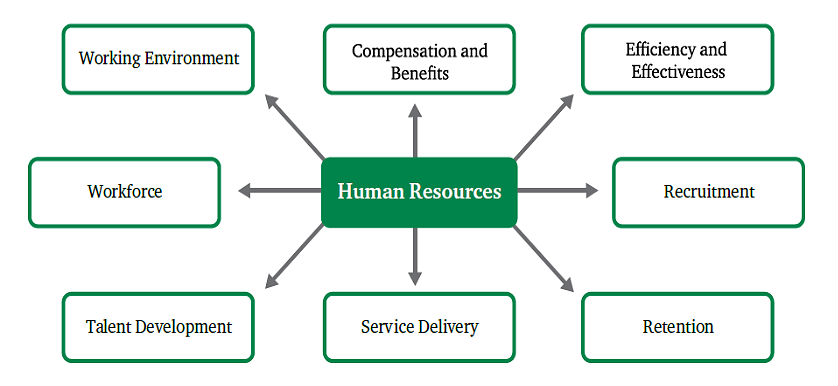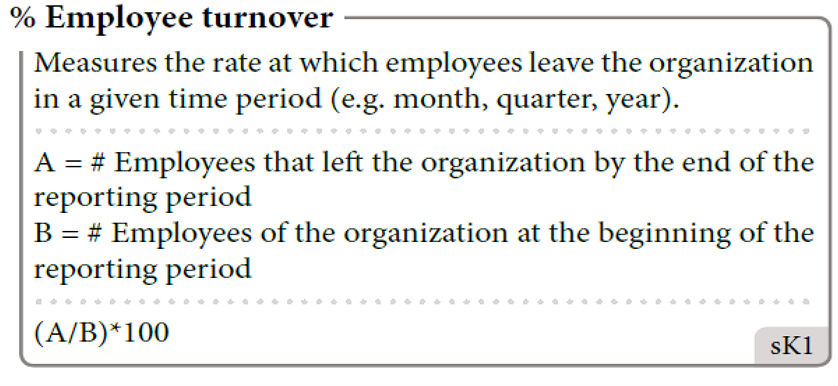How to Measure the Performance of your Human Resources Department

Every month we choose from our database of over 20,600 KPIs the most representative KPIs, as well as the ones that can be most effectively used within a certain department. Today we will talk about performance management best practices within the Human Resources functional area. Furthermore, we will provide you with KPI examples and descriptions which are often utilized by professionals from this department.
Performance in the HR department
The value of the Human Resources (HR) division within an organization resides in its capacity to fulfill its role as the primary enabler for human capital development and sustainability. Long term performance and market leadership have seldom been achieved without retaining loyal, hardworking and motivated employees.
Throughout this process, the Human Resources division has to realize the importance of actively implementing performance management tools to monitor key activities.
For performance management to function optimally within the department, its core functions and objectives should be identified in accordance to the company’s strategy. Afterwards, the most representative KPIs should be selected for the agreed-upon objectives.
Core Functions of the HR Department
Given the variety of functions that HR divisions serve in an organization, a different set of KPIs can be identified for each of these functions. The eight functions hereby presented cover the most prominent facets of the HR division.
- Compensation and Benefits-KPIs capitalize on the value of effectual reward systems.
- Efficiency and Effectiveness KPIs can be used in the measurement of productivity achievement. Service delivery KPIs reflect on the core attributes and responsibilities of the HR division.
- Recruitment KPIs reflect on the overall effectiveness of the recruitment process.
- Retention KPIs emphasize employee satisfaction, engagement and turnover.
- Talent Development KPIs focus on brandishing human capital potential in a manner that maximizes its contribution to the overall performance of the organization.
- Working Environment KPIs focus on the consolidation of a productive working environment that harnesses workforce performance.
- Workforce related KPIs reference upon its structure as part of an integrated performance management system.

HR Department KPIs
Based on the organizational and departmental strategy, and according to the formulated objectives, suitable KPIs can be selected to monitor performance for all the core functions or for the ones deemed as being of greater strategic importance.
The most utilized KPIs in the Human Resources functional area pertain to the following sub-categories:
– Retention;
– Recruitment;
– Compensation and Benefits;
– Efficiency and Effectiveness;
– Talent Development.
Common KPIs to monitor the performance of the Human Resource Department include:
Retention:
% Employee turnover
# Employee engagement index
% Employee retention rate
% Employee satisfaction
# Employee tenure
$ Job abandonment cost
$ Employee turnover cost
Recruitment:
# Applications received per vacancy
$ Cost per hire
% External hire rate
# Applications received by recruiting source
# Hired to needed personnel ratio
% Job offer acceptance rate
# Time to fill a vacant position
Efficiency and Effectiveness:
% High performing employees
$ Profit per employee
% Human Capital Return on Investment (ROI)
# Time to process payroll
$ Lost time accounting
% Performance appraisal participation rate
% Work performed by staff over-skilled for the job complexity
In Practice KPI Example
These are just a few examples from the over 370 KPIs selected by the KPI Institute and comprised within “The Human Resources KPI Dictionary” – an effective tool for understanding, selecting and working with KPIs.
The booklet contains definitions and calculation formulas for all of the provided KPIs, combining input from the smartKPIs.com community, with research and analysis from The KPI Institute’s research team. For instance, one of the most viewed HR KPIs of all time on our platform – smartKPIs.com – is % Employee turnover, which is defined by the Human Resources Dictionary as follows:

This KPI constitutes an efficient reflection of employee satisfaction, since unsatisfied employees are more likely to leave the organization. Furthermore, it can strongly impact overall performance results – for instance, a high turnover rate has a negative impact on business, due to a loss of knowledge, the cost of replacing employees and the duration of the replacement process.
The Human Resources KPI Dictionary, containing definitions and calculation formulas for all 370+ Human Resources KPIs, can be used in the early stages of implementing a performance management framework, in the process of selecting and documenting KPIs, but also for improving an existing performance measurement system.
In our next article, we invite you to discover performance management recommendations for another functional area of paramount importance for organizational success – Marketing and Communications!
Image sources:
Tags: Human Resources performance, Individual Performance, KPI






attahiru tanko mohammed
| #
I have increased my knowledge on KPIs. thanks
Reply